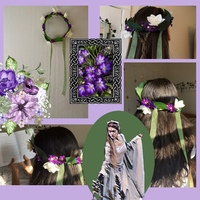The Blooming Headdress: Medieval Flower Crowns
Item
Title
The Blooming Headdress: Medieval Flower Crowns
Description
In the Middle Ages, flowers and botanics were an integral part of daily life. From culinary dishes and medicinal practices to decor and accessorization, the medieval era was blooming with plant life! Specifically, this project focuses on the construction of medieval flower crowns in 12th-century England. These floral garments were often made of leaves, grasses, flowers, and occasionally animal hair and were worn for intentional occasions such as festivals, celebrations, religious ceremonies and pageants. Additionally, these crowns were worn by men, women, and children and were a prominent part of public medieval attire. It is also important to note that these headdresses were carefully crafted with intentional materials to symbolize honour and status. For this reason, I chose to use four specific medieval plants: iris, sage, lily, and myrtle, to represent the plants of the medieval era and to make a crown that has a rich sense of floral significance. For instance, the purple iris symbolizes hope and fertility, and the white lilies symbolize purity of the soul and the Virgin Mary. Therefore, the crown I chose to construct is an embodiment of a medieval woman, as bearing children, faith, and a pure heart were things women in the Middle Ages strongly valued. Nevertheless, medieval flower crowns were a predominant part of Middle Ages life and continue to make their mark in society and fashion culture today!
Contributor
Rachel Shadid

